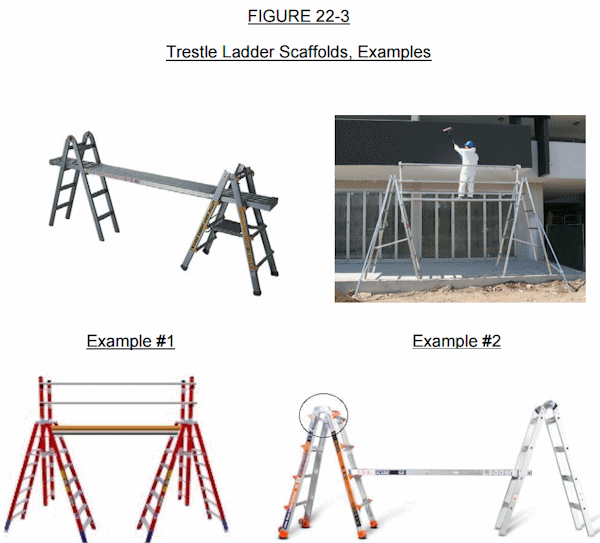22.S Work Stands (Portable Work Platforms).
22.S.01 Work stands must be designed in accordance with either ANSI A14.2 (aluminum) or ANSI A14.5 (plastic/fiberglass). > See Figure 22-2.
22.S.02 Work stands must not have a working height exceeding 4 ft (1.2 m).
22.S.03 The load rating must be clearly and legibly marked and the work stand must not be loaded beyond the manufacturer's rated capacity. The maximum intended load includes the worker and all tools and supplies.
22.S.04 When work stands are used adjacent to stairs or ramps where a fall to a different level could occur, guardrails (as defined in 21.F.01.b) or other fall protection must be provided (increased in height by an amount equal to the height of the work stand. > See Section 21.A.04.
22.S.05 Work stands must inspected for visible defects on a daily basis and must be maintained with no structural damage.
22.S.06 Job-built work stands are not allowed. Saw horses must not be used as work stands.
22.T Trestle Ladder Scaffolds.
22.T.01 Scaffold platforms must be placed no higher than the second-highest rung or step of the ladder supporting the platform.
22.T.02 All ladders used in step, platform and trestle ladder scaffolds must:
- Meet or exceed 29 CFR 1926 Subpart X.
- NOTE: Job-made ladders are not permitted.
- Be prevented from slipping by how they are placed, fastened, or equipped.
22.T.03 Scaffolds must not be bridged one to another.
22.T.04 Climbing and Working Locations. The user must climb or work with the body near the middle of the step or rung. Higher than the step or rung indicated on the label marking the highest standing level of a ladder. The user must not step or stand on:
- A ladder top cap or the top step of the step or trestle ladder, or the bucket or pail shelf of a self-supporting ladder.
- The rear braces of a self-supporting ladder, unless designed and recommended for that purpose by the manufacturer.
- The top step of the extension section of an extension trestle ladder.
- The top cap or top step of a combination ladder when it is used as a self-supporting ladder.
Knowledge Check Choose the best answer for the question.
22-19. What is required when using work stands?
You forgot to answer the question!


